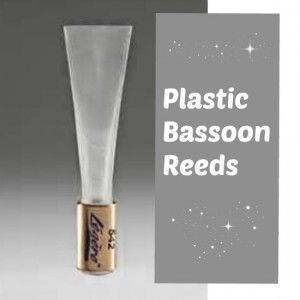 My first bassoon teacher used plastic reeds. They were thin and produced a weak sound, but I didn’t know any better. They were cheaper and easier to play on than cane reeds, so I played on them for a couple of years. Then I switched teachers. Whoa. I quickly learned that plastic reeds were the worst thing I could have done for my budding bassoon career. That was in the late ’90s.
My first bassoon teacher used plastic reeds. They were thin and produced a weak sound, but I didn’t know any better. They were cheaper and easier to play on than cane reeds, so I played on them for a couple of years. Then I switched teachers. Whoa. I quickly learned that plastic reeds were the worst thing I could have done for my budding bassoon career. That was in the late ’90s.
Plastic reeds have come a long way, my friends.
While most plastic reeds are still terrible, there is a new player in town. I was first introduced to Legere reeds by George Sakakeeney (Professor at Oberlin). He played one for me and said that it could do 90% of what a really good cane reed could do. Quite the endorsement! As I have yet to make the financial commitment (they cost over $100 each), I’ve chosen to feature the remarks of my friend—bassoonist Elizabeth Crawford—who has played on and owned quite a few Legere reeds. In her words:
I was immediately impressed with the tone color and response. Very dark, lovely sound with easy response throughout all registers. Most impressive was the strength and stability of the top octave which clearly benefits from the structural strength of the reed. I played for several minutes in awe of how much better it was than I expected.
What I began to realize though was that the aperture was much more closed than I am accustomed to playing on. The more I played, the more I realized that with the smaller tip opening, I couldn’t play as loud as I wanted to or dig into my bottom octave. The pitch was on the high side and I was unable to bring it down.
Though I was immediately impressed, I realized that there were some severe limitations. I returned to the reading material that was included and attempted to make adjustments to the tip as the directions instructed. However, the adjustments I made simply did not last. In addition, the caution against damaging the reed by breaking the sealed sides made me very nervous and conservative with my attempted adjustments.
A few weeks in, one of my colleagues emailed to see how I felt about the reed. I shared that the aperture was too closed preventing the reed from being free-blowing and made it sharp in pitch. I told him I wasn’t able to make meaningful adjustments to the tip. He enlightened me to better adjustments:
‘Regarding a more open aperture, the web site mentions to heat the water to 194 degrees, place the reed in the water for 30 seconds, remove with tweezers, gently insert a plaque and place in cold water for one minute.’
I attempted the adjustment. Placing a plaque in the tip, into the hot water and then into the ice water. THIS WAS THE PERFECT ADJUSTMENT! Immediately the read was fully vibrant, right on pitch, capable of full dynamic range – exactly what I wanted.
After the highly successful tip-plaque adjustment, I was contracted to perform rehearsals and concerts in Kalispell (2,500 feet) with temperatures between 55′-65′ degrees and lots of humidity and rain compared to 3,500 feet and mostly dry here in Great Falls. I was a little uncertain upon arriving at my first rehearsal but I figured that since it was a Pops Concert and I wasn’t in my home orchestra, it was worth the risk. The first rehearsal went well. Before the concert the next evening I made the tip-plaque adjustment one more time and was impressed that it improved the reed even more, making it more free-blowing and vibrant.
An outdoor Pops Concert was the ultimate use for it. The weather was cold and though our conductor kept talking at length between pieces, I didn’t have to worry about the reed drying out, becoming too hard, or going flat with the temperature. Furthermore, I wasn’t ruining a great cane reed on a fluff concert.
I am very excited about the Legere reed! I purchased a medium strength reed. Though I still have not achieved a complete ppp dynamic worthy of a second bassoon audition (see previous blog posts), I feel very pleased with the dynamic range it offers. The tone color in all octaves is desirable: focused, projecting, consistent. I am now able to punch out my bottom octave in a ff dynamic. I love the projection of the top and mid-range. It’s very easy to push the reed without it becoming harsh or too reed-y. It has sizzle but not an offensive buzz. I am still experiencing some muscle fatigue in my jaw after about 2 hours of consistent playing but I think I might be able to eradicate that simply over time as I become conditioned with it or perhaps trying the soft hardness that Legere also makes the reeds in.
You can read Elizabeth’s post in its entirety at her blog. She also has a very helpful YouTube video that shows her making the adjustments to her Legere reeds:
You can purchase Legere reeds from:
I actually saw the Aspen Winds bassoonist play with a plastic reed. I never saw a professional play with one of this material. I wonder if it is this brand?
I’m am almost sure it’s this brand. There aren’t any other good ones out there. I’ve heard good things about their clarinet reeds. Try one out and let me know what you think!